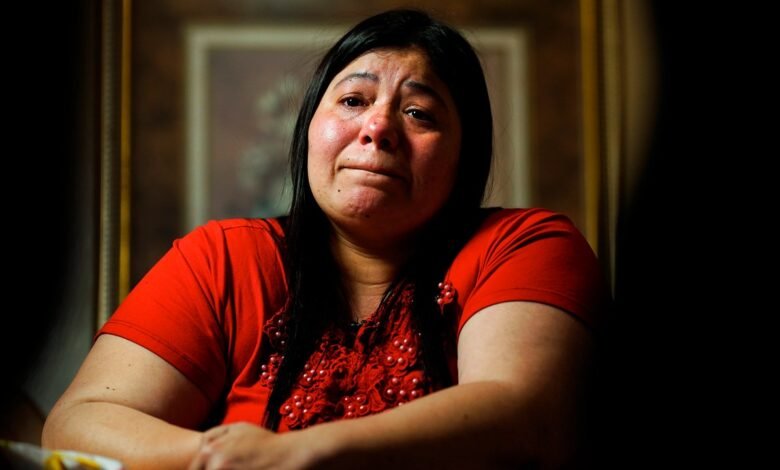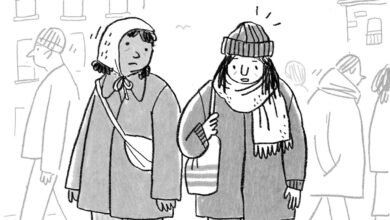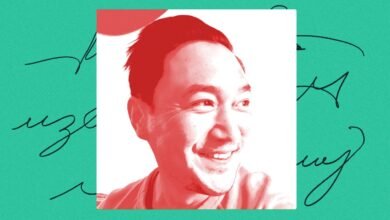“Do I Have to Come Here Injured or Dead?”

Now, cuffed and shackled, Keldy was a criminal defendant, charged with a misdemeanor. She had committed two phone numbers to memory—the first for Mino in East Texas and the second for her sister Claudia, who was living in Philadelphia, an asylum seeker herself. Since Mino still had no immigration papers, Claudia would have to sponsor Erick and Patrick to get them out of custody. Keldy couldn’t speak to them because, in the government’s databases, her file was severed from those of her children. Patrick and Erick were listed as “unaccompanied alien minors” who had arrived at the border alone and been transferred to the Department of Health and Human Services. H.H.S. would take up their case from scratch, vetting relatives in the U.S. Keldy was part of a different system run by D.H.S. It treated her as a “single adult.”
Within a week, Keldy was moved to a detention center run by ICE on Montana Avenue, in El Paso, a complex of low-slung buildings that resembled a cross between a prison and a military barracks. The closer you got to the front parking lot, the more impregnable the space became, with thick doors under lock and key and long hallways of cinder block and Plexiglas. Deeper inside, past a small library with a few computers and a bank of phones, were dormitory blocks with dozens of bunk beds. The rooms opened onto the yard, a square plot of asphalt ringed by high walls, where the detainees were given an hour each day for “recreation.”
On the morning of October 4th, one of the guards brought Keldy to a small room with bare walls. On a metal table was a phone. Someone identifying himself as Officer Su came on the line. He spoke in English, followed by another voice piped in from somewhere else, which translated everything into Spanish. Su, an asylum officer at Citizenship and Immigration Services, was sitting in a cubicle in an office building in Arlington, Virginia. For the next two hours, Keldy would answer questions to establish whether she had a “credible fear” of persecution in her home country. It was the first hurdle to clear for asylum. The second was an actual hearing before an immigration judge.
“Please remember to speak clearly and loudly, and also take frequent pauses so the interpreter can accurately tell me everything you say,” Su told her. “Before we continue, I’m going to place you under oath.” The guard was gone; Keldy was alone in the interview room. Facing in the direction of the phone, and blinking hard at the emptiness before her, she raised her right hand and swore to tell “the truth, the whole truth, and nothing but the truth.”
Keldy had spent months back in Honduras gathering evidence for asylum. But speaking to a disembodied voice on the phone, she stumbled through the story. Certain details didn’t line up with the pointed sequence of questions. The asylum officer needed to establish specific facts. Who murdered her four brothers? “We never knew the names,” she replied. “It was between 2006 and 2012. The last death was July, 2012. That one brought my entire family a lot of consequences as far as persecution.”
These killings took place “five years ago,” Su pointed out. Was there still a threat to her personally?
“Yes, but we’ve been in different parts of Honduras,” she replied.
The time line was jumbled because the threats had come in waves: there were her siblings’ killings, then the fallout after Keldy testified against their killers in court. The interpreter stopped translating and tried to get Keldy to respond to the officer’s question, but she was getting nervous. “Ma’am, stop,” Su interjected. “We’re already an hour into this interview, and I haven’t gotten any information I need.”
The interview concluded at 1:46 P.M. “Is there any other reason you fear returning to Honduras?” Su asked.
“I have nowhere to go in Honduras,” Keldy said. “My family is all in Mexico or the United States.” It was another week before she learned that she had passed.
This was welcome news, which nevertheless seemed to have no immediate bearing on her situation. Ordinarily, asylum seekers who cleared this first test could be released on bond to wait for their subsequent court dates. But increasingly the government was trying to detain asylum seekers through the entirety of their legal proceedings. In one case, a Haitian professor of ethics had won asylum in an immigration court, yet was kept in ICE detention for two years while the government appealed the case. On the initial form that came back to Keldy, with a box checked to indicate that she had “demonstrated a credible fear of persecution or torture,” she was ordered to appear before a judge in a separate room at the facility on Montana Avenue, where she was already being held. The two blank lines reserved for the date and time of this court hearing read, “To be determined.”
By the late fall of 2017, the pilot program in El Paso was attracting more attention. A senior staffer at the Department of Health and Human Services noticed a pattern and e-mailed Kevin McAleenan, the head of U.S. Customs and Border Protection. Not only was the department running out of bed space for unaccompanied children in government shelters, the staffer pointed out, but a significant share of the children entering H.H.S. custody didn’t appear to be unaccompanied at all. That fall, Miguel Torres, a magistrate judge in El Paso, voiced his own misgivings in open court. “I’ve probably done thousands” of these cases, he told lawyers. “This is a newer phenomenon.”
In November, four parents and a grandmother from Honduras and El Salvador appeared before Torres. Each had been charged with a misdemeanor for illegal entry, but none of them seemed to care about the outcome of the case. They claimed that the Border Patrol had taken their children, and that they had no idea where the children were. Their lawyer was a public defender from Mexico City named Sergio Garcia, who had first come to the U.S. in 1981, to study English at the University of Utah. His clients were so desperate to reunite with their children that they were willing to plead guilty to anything. “Instead of giving them due-process rights to a hearing on asylum, or refugee status,” he told Torres, “the government is just kidnapping their children.”
For weeks, Torres had been seeking an explanation for why so many parents seemed to be getting separated from their children and then kept in the dark on their whereabouts. The government prosecutors insisted that nothing was out of the ordinary. From the bench, Torres disagreed, saying, in reference to the parents, “I would be very worried as well if it was me.” There were some two hundred and eighty parents who’d been separated from their children under the initiative. Having twice been denied bond, Keldy was still in detention on November 18th, waiting for her hearing before an immigration judge, when C.B.P. ended the El Paso pilot.
Stopping the pilot had a perverse consequence for her. Without a scandalous new policy to concentrate public attention, Keldy was just another single adult from Central America languishing in ICE detention. On Montana Avenue, she was assigned to a dormitory block known as 8D, with about thirty other women who were given orange jumpsuits and strict instructions. Each group of detainees moved through the space as a unit. They ate together, shared a recreation hour, and lounged around the dorm and talked. Contact with the other groups was forbidden. Sometimes, they would pass one another in the hall, or overlap briefly in the commissary. When a woman lingered over her food and tried to make conversation, a guard was usually on hand to shout a reprimand: “You’re here to eat, not to socialize.”
By April, 2018, six months had passed since Keldy’s preliminary asylum screening, yet she was still in detention, waiting for a hearing before a judge. Mino had put money on her phone so that she could call her sons every week, at a rate of eighty-five cents per minute. From their short, awkward calls—full of silences, monosyllables, repressed sobs—she could tell that they were floundering without her.
Of all the places in the U.S. where Keldy could have applied for asylum, El Paso was one of the worst. On average, roughly a third of asylum seekers were given relief in immigration courts across the country, but immigration judges in El Paso had granted asylum just three per cent of the time between 2013 and 2017. One judge called the city’s immigration court system the “bye-bye place.”
Unlike criminal defendants, immigrants aren’t automatically granted a lawyer. The longer Keldy remained in custody, the harder it was to find someone who could help her get out. Occasionally, the other detainees would see Keldy crying softly to herself or staring off into space with bloodshot eyes. But she never seemed despairing. “God is the only one who can help us,” she told one of them.
Coming from someone else, that may have sounded fatalistic or zealous, but because Keldy spoke the words the other women took them as a sign of spiritual vigilance. She led prayer sessions each day in the yard, where dozens of women joined her. They approached her to ask whether she saw them in her dreams. Some of them now called her la profeta, the prophet.
Two female guards watched Keldy with growing annoyance. One of them had red hair, the other blond. The detainees called each guard La Miss, attaching the Spanish article to the English honorific. But they secretly nicknamed the blonde La Chucky, because her swept bangs resembled those of the murderous toy doll in the horror-film series. Both guards found endless excuses to sanction Keldy. They confiscated her Bible, barked at her in front of the others, and cut her prayer services short. At night, lying on their cots in the barracks where they slept, Keldy and the others speculated in hushed voices about why these two guards were so fixated on her. The harsher they were, the more Keldy stood out as an undimmable force. After a few months, even detainees who weren’t religious or whose Spanish was weak stayed close to her.
Toward the end of April, 2018, when the Trump Administration’s zero-tolerance policy fully went into effect, Keldy started to notice more women claiming to have been separated from their children. By the start of May, she counted around twenty mothers in and around her unit. All of them were inconsolable, too traumatized to speak in full sentences. They sat off by themselves, moaning. It would be several days, at least, before they had any inkling of where their children were. Keldy knew enough not to try to talk the mothers down. She sat and cried with them. Some of the women knew about her own children, but many didn’t. She volunteered the information only if asked. To everyone, though, she said the same thing: “Someone will come and help us. I’m going to make sure of that.”



